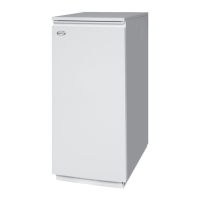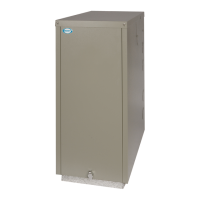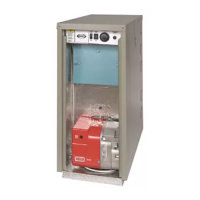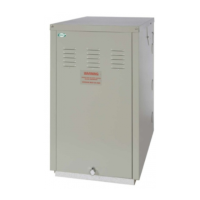29
Grant Vortex Eco Utility Oil Boilers
5 - CONDENSATE DISPOSAL
Grant Vortex Eco boilers are supplied with a factory-fitted
condensate trap to provide the required 75 mm water seal in
the condensate discharge pipe from the boiler.
This trap incorporates a float (which will create a seal
when the trap is empty) and an overflow warning
outlet (fitted with a plastic sealing cap), See Fig. 15.
Condensate trap
5.5
Care should be taken when siting the trap such that the
overflow outlet is readily visible and that any
condensate overflowing from the outlet cannot cause
either a hazard to persons or damage to surrounding
property or equipment.
The condensate trap outlet is at an angle of 48° below
the horizontal. This is to automatically give a 3° fall on
any 'horizontal' runs of condensate disposal pipe. Refer
to Fig.15.
The outlet of the trap will accept 21.5 mm to 23 mm
OD Polypropylene overflow pipe for the condensate
discharge pipe.
This discharge pipe can exit through the left hand side
of the boiler through one of pre-cut 'knock-outs' in the
casing panel (see to Fig. 1). Push out the 'knock-out'
from the required hole taking care not to distort the
side panel.
The trap MUST be checked at regular intervals (e.g.
on every annual service) and cleaned as necessary to
ensure that it is clear and able to operate.
Note: The bottom bowl is sealed to the trap body and
cannot be removed.
To inspect and clean the trap:
1 Disconnect flexible condensate hose from inlet
connector.
2 Unscrew the inlet connection nut.
3 Remove the inlet connector and nut from trap.
4 Remove trap from bracket.
5 Remove float from trap – clean if necessary.
6 Inspect inside of trap and clean as necessary.
7 Re-assemble trap, re-fit to boiler and re-connect
flexible hose. Ensure that hose is fully pushed onto
the trap inlet connector.
IMPORTANT: Failure to regularly check and clean
the condensate trap may result in damage to the boiler
and will not be covered by the Product Warranty.
Fig. 15 - Condensate trap
The trap is factory-fitted inside the boiler casing
(mounted on the inside of the left side panel) in an
accessible position to allow for routine maintenance.
Note: If required, this condensate trap may be re-located
outside the boiler casing. Refer to procedure given in
'external condensate trap'. This procedure MUST be
carried out before the boiler is installed.
A flexible hose connects the outlet of the condensing
heat exchanger to the trap inlet. Ensure the straight
connector on the hose is fully pushed onto the 'top hat'
inlet connector of the trap.
With the trap fitted inside the boiler casing, the sealing
cap MUST be fitted. If the trap is re-located outside
the boiler then the following applies:
If connecting the condensate discharge (either internally
or externally) into a waste system or soil stack - the
sealing cap MUST be fitted in the trap outlet.
On external discharge systems to a hopper, gully or
soakaway, the sealing cap should be removed from the
trap outlet.
If there is any discharge of condensate from the overflow
outlet, this could indicate a blockage (possibly due to
freezing). Turn off the boiler and investigate the cause. If
necessary contact your service engineer for assistance.
Condensate disposal pipework
5.6
Inspection and cleaning of trap
5.6
Condensate
trap
Condensate
outlet to
drain
Overflow
warning
outlet
(with cap)
Condensate
drain pipe
from boiler

